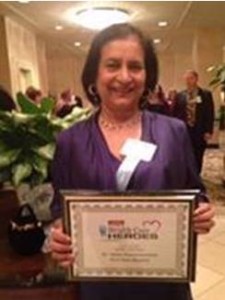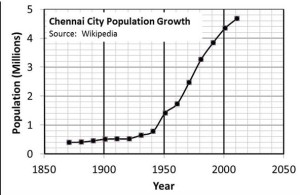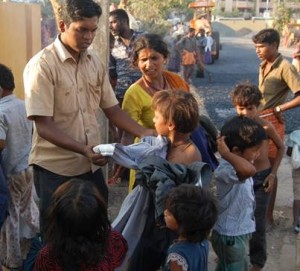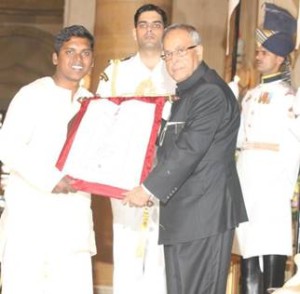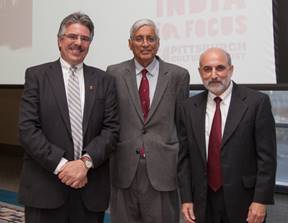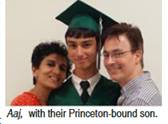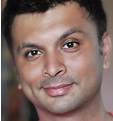Dr. Nilima Karamchandani Receives The 2015 Health Heroes Finalist Award
Posted by admin in January 2016 on December 28, 2015
Urvashi Surti, Ph.D., O’Hara Township, PA
Congratulations! Dr. Nilima Karamchandani, MD, specializing in neonatology, was the finalist for the Lifetime Achievement Award for this year’s Health Care Heroes Award. In an event organized by the Pittsburgh Business Times with High Mark Blue Cross Blue Shield as the presenting sponsor and Allegheny Health Network as the event sponsor, Dr. Karamchandani received the honor on September 9, 2015, in their annual event at the Omni William Penn Hotel.
Dr. Karamchandani has spent her entire professional career ensuring that the most fragile new-born babies in western Pennsylvania have a fighting chance to live a normal, healthy life. As Chief of the Division of Neonatology and Medical Director for the Infant Apnea Center at West Penn Hospital for the past 37 years, Dr. Karamchandani has been a nationally recognized authority in neonatology, particularly in treating infant apnea and preventing Sudden Infant Death Syndrome (SIDS).
Under Dr. Karamchandi’s leadership, West Penn Hospital’s Neonatal Intensive Care Unit (NICU), the leading referral center in western Pennsylvania for sick and premature newborns, now cares for more than 700 babies each year. At West Penn, she established one of the country’s first infant apnea centers and the developmental follow up program for premature infants.
As a founding board member of the Greater Pittsburgh SIDS Chapter, Dr. Karamchandani also served as president of the National Association of Apnea and the American Association of SIDS and Safe Sleep Programs. She has published numerous scientific papers on infant sleep apnea and risk for SIDS, while also helping lead clinical trials of new medications to treat deadly infections in infants.
Of her many accomplishments and contributions to neonatology medicine, Karamchandani cites her research with SIDS and development of educational programs to reduce the incidence of this devastating fatal condition as the most important. Among these initiatives was the national “back to sleep†campaign (now called the “Safe to Sleep†campaign) that is credited with significantly reducing SIDS deaths in America.
For her dedication and commitment, Dr. Karamchandani has received a long list of accolades and recognition over the years, including the city of Pittsburgh’s “Women in Medicine Achievement Award†in 2005, Celebrate & Share’s “Woman of Achievement in Medicine,†award, membership in the Guide to America’s Top Pediatricians by Consumer’s Research Council of America, and “Top Doctor in America†recognition by Consumers’ Guide to Top Doctors.
Nilima was a graduate of Seth G.S. Medical College and King Edward Memorial Hospital, affiliated with the Bombay University in India. As a daughter of an Indian Air Force officer, Nilima spent her childhood all over India. Her mother was a professor of English.
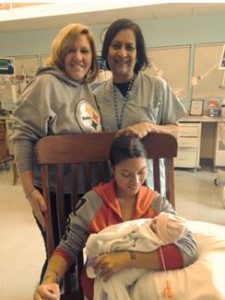
Nilima with her two patients, Becky Brindle in 1972 and her premature grand daughter 43 years later.
Karamchandani did her fellowship in neonatology at Magee Womens Hospital. She has also trained new generations of physicians and other healthcare professionals in neonatology and pediatrics, serving as a clinical assistant Professor of Pediatrics at both the University of Pittsburgh School of Medicine and Temple University School of Medicine.
She lives in Fox Chapel with her husband Manu Badlani, PhD, a mechanical engineer. They have three sons and three grandchildren.
Decades ago, when we were looking for a pediatrician for our daughter, Dr. Nilima Karamchandani was our obvious choice. I had known her as a fellow student in Mumbai at St. Xavier’s College. In 1972, Dr. Karamchandani had already been in the local paper during her training for saving a prematurely born baby when others had given up. Karamchandani also delivered a normal baby for one of her patients decades ago, whose daughter had a premature delivery under Dr. Karamchandani’s care. See the picture of all three with Karamchandani.
Dr. Karamchandani retired this July. Her other interests include travel, embroidery and reading. She is also busy traveling to her sons and taking care of the grandchildren. The Karamchandanis are on the board of trustees of the Hindu-Jain temple. Nilima is at present the president of the Triveni International Club. ♦
The Chennai Floods – How A Natural Event Became A Man-Made Disaster
Posted by admin in January 2016 on December 28, 2015
By Kollengode S Venkataraman (December 2015)
Chennai, the fourth metropolis of India with a population of nearly 5 million people in the city and over 8.5 million in the expanded metro area, was inundated with incessant rains during November starting from Deepavali. This is the normal northeast monsoon season for the east coast of Southern India. Chennai received over 140 cm of rains (2.5 cm = 1 inch) during a 2-week period. This was unusually high against the normal annual rainfall of 45 cm. Such high rainfall happened nearly one hundred years ago, and was probably spread over a much longer duration. But Chennai city’s population was only 0.5 million then, with much less population density, because high-rise buildings were unknown. See the plot.
Climate change on account of human recklessness on a global scale is one contributing factor for this excess rainfall. But other local contributing factors, centered on Chennai’s reckless urbanization and growth, made the natural event into an urban disaster. Every other urban areas in India — New Delhi, Mumbai, Kolkata, Bangaluru, Hyderabad, Kochi-Ernakulam and other emerging cities — has similar foot prints in reckless urbanization. In the future, urban planners in India will use — or at least should use — the Chennai Floods of 2015 as a bad example on what not to do in urban development.
In the Tamil medium high school social studies class we were taught that the geographical area around Chennai, in the absence of any river basin, has a unique irrigation system for farming. This system, called Aerip-Paasanam in Tamil, has been in vogue for over a millennium, as the historical records show. Aerip-Paasanam, literally means Lake Irrigation. The whole region is relatively flat without any large river system like the Kaveri, Krishna, and Godavari delta in Southern India. The local rulers and land owners over the last 1000 years dug large tanks and built lakes, and de-silted them periodically, to collect the rain water during the 2 to 3 month monsoon season. They used the water thus pooled for irrigation for raising at least two crops annually. Old maps of the area show the area dotted with hundreds and hundreds and hundreds of water bodies, big and small.
Even in Chennai City, many places, before they were renamed as fancy Nagars (Anna Nagar, Kalaignar Nagar, Indira Nagar…), had the word Aeri (lake) attached to them, as in Velacheri, Otteri, Nungambakkam Aeri, Mambalam Aeri. These densely populated places, now innocuously called “low-lying areas,†were once actual lakes.
In the last 40 to 50 years, India has seen huge migration of rural population on a national scale to urban centers all across the landscape. Both the educated and the poor from every region have moved in millions into every other region on a scale unheard of to get better jobs, or simply to eke out a living.
Obviously there are great pressures on every resource in urban India, such as housing, drinking water, sewage, transportation, schools, shops for all kinds of goods and services… India’s expanding middle class has increasing access to many resources that come with education, wealth and money. However, India’s middle class and the affluent do not want to pay taxes, but expect all kinds of services from governments (ref:www.tinyurl.com/G20-IndiaTaxBase).
In Chennai’s case, the unenlightened self-interests of the segments listed below got aligned with disastrous consequences in the 2015 Floods: populist and corrupt state and local elected governments; vote-bank politics; ever increasing middle class needs for goods and services; people’s unwillingness to pay for it in taxes; land, real estate, and construction mafia; an acquiescing bureaucracy and criminal justice system; and the simple human greed to get rich quickly in the real estate boom. NRIs too would have contributed to this with their access to hard currencies.
In recent decades, in Chennai and other urban centers, politicians started real estate businesses in the names of their spouses, sons, family members, making huge commissions in real estate transactions. They have all the inside information in governments, and use strong-arm tactics to acquire urban and suburban land. In this environment, the lakes and low-lying areas became multi-story housing complexes with fancy names within the city and in the suburbs along the new freeways. These freeways were also built along the low-lying areas, often built across river beds. Government buildings, private hospitals, glitzy IT “campuses,†even private universities, were built on the lake beds.
Chennai once had 12,000 hectares of ponds and lakes (1 hectare = 2.5 acre) for collecting the rain water. Today it has only 600 hectares. And the three small rivers that drain the Chennai’s rain water into the Bay of Bengal are today open sewers. The estuaries of these rivers are not dredged regularly to facilitate the draining of rain water into the sea. And the larger lakes in the region are not dredged regularly and kept in good repair to increase their water storing capacities.
The migrating rural poor people have occupied the catchment areas around these rivers and the river beds themselves — where else can they go? — to eke out a living. With vote-bank politics having become the standard, elected governments have “regularized†the occupancy of people living in these low-lying areas, giving them titles for the land. Having obtained the land for free, they built regular houses on this land.

In this rain season, the first floors in the multi-story housing complexes built with government approval were flooded with 6 to even 10 feet of water. These people have lost their personal belongings and suffered heavy losses. Those occupying higher floors, even though did not suffer personal losses, would see their net worth reduced because of the drop in the market value of their apartments. Here are the samples of pictures of the Chennai Floods of 2015: http://tinyurl.com/Pics-ChennaiFloods .
Even if 200,000 apartments need to spend, say, only Rs. 200,000 per apartment for repairs , you are talking about Rs. 40,000,000,000, or Rs. 40 billion, or 4,000 crores in personal losses. Then they need to rebuild roads and other damaged infrastructure. Many thousands of poor people have lost their whole house built on the “regularized†lands along the river bed granted to them for free. There is no way any government can compensate for these people’s personal losses.
So, we cannot call it a “natural†disaster, any more than Katrina was a natural disaster. The 2015 Chennai rains is a severe natural event that became a man-made disaster by the reckless omissions, commissions and sins in urban planning, and in the management of urban growth, and tardiness in preparing for the monsoon by the elected governments. And this was made worse by the total lack of respect for the land, its terrains and its environs by every Chennai-vasi, both rich and the poor, educated and the uneducated, powerful and the weak. But the onus on the rich, educated and the powerful for this man-made disaster is far greater. Every Chennai-vasi – the anglicized would hate this rustic term, their preference is Chennaiites – has directly and indirectly contributed to this disaster.
But as it happens in India, nobody will be held accountable and nobody will own up responsibility for the man-made disaster. Those responsible will hide behind Climate Change and the Act of God.
This man-made disaster needs a drastic package of solutions requiring thousands and thousands of crores of rupees and long time frame to get to the root causes and then fix them. Some of these are: restoration of the natural ponds and lakes all along the coastal areas prone to puyals, cyclones and hurricanes; a plan in place for the periodic dredging of the estuaries of the three rivers in Chennai at the sea, and keeping water flowing in the rivers snaking around Chennai. These rivers are cesspools now; resettling the poor people living along the riverbeds and basins in safe places and giving them homes they completely lost; and keeping the river beds free from future encroachments. These are not easy.
Since every Chennai-vasi has directly and indirectly contributed to this disaster, every one of them also has to pay for it for fixing it, maybe through a 0.5% Floods Tax on their income and a small raise in sales tax. After all, they have been making their money out of Chennai’s growth.
This requires a major course correction in the lifestyles for the Tamil society as a whole, particularly among the educated Tamil established classes and its political and social elites since they are the trendsetters. Arasan evvazhi, avvazhi makkal, or Yatha raja, tatha praja. The Tamil society and the sizable non-Tamil residents of Chennai metro area need to understand and respect their own ecosystem and design a lifestyle around it, rather than transplanting a lifestyle that worked somewhere else faraway under different ecosystems. Whatever is true to Chennai is true for every other Indian metro area.
Long term, India has to evolve a policy to disperse its population in newer smaller cities all across the nation instead of making the existing metro areas grow and grow, till they simply collapse, as Chennai did.
On media coverage, the Tamil print media did a far better job in getting the historical information on the regions’ water management policies over the last 800 to 1000 years by going to original sources in the Tamil language. Here are the examples:
1. tinyurl.com/Dinamani-MaraVendumManobhavam by N Gurusami
2. tinyurl.com/varumum-kAvathAn by R. Rajagopalan
3. tinyurl.com/katrukkolla-maRukkiROm by Mr. K. Pazhanitthurai
The titles of the articles in translation tell everything about its contents: The Mindset Has to Change; The Life of the Person Who Never Prepares; and We Refuse to Learn.
The English print media (The Hindu and others) did a pretty bad job on this point. This is understandable. Both its anglicized writers and semi-anglicized urban readers are completely cut off from their own hinterland linguistically, culturally, and ecologically. END
A Remarkable Story on Compassion & Caring
Posted by admin in January 2016 on December 28, 2015
By Krishnaa Raman, Savannah, GA
e-mail: araman83@aol.com
Recently, I was in Kochi, India, to be with my only sibling, my sister Meena, to mourn the passing of my mother. One of my uncles happened to be visiting from Delhi, and he performed the cremation rites and the ceremony of mixing the ashes with the waters of the Arabian Sea. According to tradition, women cannot perform the subsequent eleven days of the last rites for the departed, and so my sister and I decided that we would feed the poor and destitute on three days. We also felt that Amma would be very happy with our decision!
My sister talked to one of her friends who suggested going to this building where Murugan, an auto rickshaw driver, takes care of about thirty people. We got to his place at 11:30 am and arranged with a caterer to bring lunch around noon time. This young man of thirty-two, Murugan, has photos of getting recognition from the President of India, Sri Sri Ravi Shankar and other notable people; laminated copies of all the articles written about the work he has done were on the wall.
I asked him how he got involved in this work of rescuing street children and the really poor, destitute people on the streets.
“I had spent ten years in an orphanage, because my father was an alcoholic. Brother Mavooris, a well-known social worker in Kochi, gave me a new lease on life at Don Bosco Snehabhavan, taught me to speak and write in Malayalam, and helped me complete my high school education in the open school system.Â
“I then decided that I am going to help children who were wandering in the streets. I did not want to ask for donation. So, I learnt to drive an autorickshaw for funds to support this cause. So far, I’ve rescued over 2,000 children.
“I have developed a procedure for this to get support. I inform the police when I see a child on the streets before taking them to the orphanages where I feel they will be safe and also get an education. I also follow up on their care.â€
“How do you end up taking care of adults too?†I asked.
“In the last few years, I saw older people on the street abandoned. I started picking them up; many are mentally ill and physically sick. I get the police involved, give them a bath, take them to a hospital where the doctors who I personally know, and who know my work, can check them out and give them proper treatment. They give these people medicines. I transport them for court appearances if needed, and then find an institution to take care of them. Some of them now live in a building that the city has donated to me.
“I have a few goats for milk, some chickens for eggs, and a vegetable garden. I recently received ambulances donated by a large petroleum company. In spite of the publicity I’ve received from the press and television, I am often short of funds for the care of these abandoned people. The problem is so huge.â€
I was awe-struck to see what Murugan has accomplished at his young age! How does an eighteen-year-old know what his life’s purpose is? Then how does he focus in on working towards that goal with his own situation so precarious?
Murugan told me he does not ask anyone for funds, but manages with whatever he gets. Evenings are spent driving his auto rickshaw, so he can support his wife and his new-born baby and get the funds required for “his people.â€
His daytime is devoted to his social work, taking care of the people no one wants. I consider it a blessing that I got to meet Murugan, someone extraordinary. Meeting Murugan has renewed my faith in humanity.
To know more about the details and challenges of Murugan’s work, go to www.theruvoram.org.
Youthful India
Posted by admin in January 2016 on December 28, 2015
Premlata Venkataraman
For decades, I recall from my younger days, India’s thinkers and rulers described its population as a problem in political discourse. But these days, India’s Prime Minister Modi frequently boasts on the global stage that India is filled with youthful energy, with 30% of its 1.25 billion people between the ages of 6 and 30 years. He is deftly turning the tables on looking at India’s younger population as an opportunity, if only we know how to harness it.
During a recent visit to India, this heady exuberance was staring at me wherever I went. It was no idle boast. Living in Pittsburgh with an aging population — Pennsylvania is one of the most geriatric states in the union — we have become accustomed to see aging people running airports, shopping malls, grocery stores, and a slower pace of life.
In direct contrast, just landing in India brings one face to face with the energetic bustle of India’s youth.Even arriving at the sparkling new airports in Kochi, Bengaluru, Hyderabad, Mumbai or New Delhi, you see everywhere young employees in slick uniforms striding along briskly, ready to solve passengers’ problems. If one feels a little gray and tired in the face of this energy, rest assured, it is not just the long journey, but India’s bubbling youth staring at you.
Of course, as India’s youth seek the holy grail of success, what they need is quality education and skills allowing them to compete locally and globally. Doors are literally opening for educated, skilled, and qualified Indians all over the world. In the changed atmosphere in India today, even IITs have opened more campuses. Engineering colleges, especially those in information technology and computer science, have chaotically sprouted up throughout the land to meet the demand. Indian youth is so attuned to opportunities that if there is a slight drop in demand in certain fields, the enrollments in colleges in those disciplines drops drastically, much to the chagrin of the new colleges without reputation.
Needless to say, for young people, having the right multinational employer and an upwardly mobile career give a lot of disposable money. India’s new consumer economy is looking precisely for this demographic slice to grow and prosper. It is no surprise that there is a mall in every suburb, selling the most upscale designer merchandise, and bars and food joints all around.
Young people with more money than their parents and grandparents had accumulated over their lifetime live a lifestyle that is quite alien to the elders. Eating out at fancy eateries, dressing in the most fashionable clothes and driving high-end foreign automobiles have become quite de rigueur. Throw in also weekend jaunts to Sri Lanka, Thailand, Singapore, and Dubai for singles…
At the fancy new airports in India, you find affluent young parents with children in tow going on vacation to the choice spots of the world. Not long ago, flying in India was for the wealthy and businessmen; for others, it was usually only for family emergencies.
But the picture is not all rosy for the new Young India. If manufacturing and service sectors are not able to provide jobs for teeming millions, they will hit turbulence. Countries having a lot of young people who don’t have jobs encounter social unrest. Look at Greece and Spain.
If India is to avoid this, its federal and state governments and its burgeoning businesses need to grow at a pace fast enough to absorb its young with jobs. For this to happen, its manufacturing and service sectors have to further expand, for which a good infrastructure is necessary.
As long as every segment of India feels that it is getting a slice of the pie, there will be economic mobility and hence social stability.   ♦
Duquesne University School of Law Hosts “Gandhi: The Lawyerâ€
Posted by admin in January 2016 on December 28, 2015
By Meghan Collins
Duquesne Law Student and Juris Editor-in-Chief
Note: Shankar Rao Dittakavi, a long-time resident of this area and a well-wisher of the Patrika from its very first issue, is Associate Director at the Duquesne University Center for Legal Information and Allegheny County Law Library. He informed us of this program.
On Thursday, November 5, 2015, Duquesne University School of Law presented an insightful program exploring Mahatma Gandhi’s young life as an attorney in India and South Africa and how the years impacted his future as an international human rights leader.
Dean Ken Gormley organized “Gandhi: The Lawyer†and moderated the panel discussion with two Gandhi scholars: Rajmohan Gandhi and Charles R. DiSalvo.
Rajmohan Gandhi is the grandson of Mahatma Gandhi and a well-known author, scholar and humanitarian. In his career, he has written extensively on South Asian history with a special focus on dialogue and reconciliation between divided communities, including between Hindus and Muslims in South Asia.
Charles R. DiSalvo is the award-winning author of M.K. Gandhi, Attorney at Law: The Man before the Mahatma (Berkeley: University of California Press, 2013). He holds the Woodrow A. Potesta Professorship at the West Virginia University College of Law, where he teaches on civil disobedience.
Mahatma Gandhi, as most people know, was one of the greatest figures of peace in the 20th century. Yet many people do not know that Gandhi was formally trained as an attorney. It was during his time in London that he began to find his calling as a civil leader for the people of India.
The panelists introduced interesting insights into Gandhi’s journey and who he was as a man rather than solely as a political figure.
Gormley asked why Gandhi’s transformative experience of getting forcibly kicked out of a first-class train car in South Africa because he was not white was so significant.
Charles DiSalvo discussed that it was this moment coupled with a courtroom incident, where Gandhi was told to remove his turban, which inspired Gandhi to do something about the way Indians were treated.
“In South Africa, when he found his purpose, he found his voice,†said Rajmohan.
Rajmohan said of Gandhi, “His genius was finding a way to involve millions of people while pointing out the absurdity of British rule.â€
Gormley ended the discussion by asking how Gandhi’s training as a lawyer and his experiences as a lawyer helped shape the person he was, and ultimately what his legacy is.
Charles DiSalvo commented that “The most important thing [that he took from being a lawyer] was that he was turned into a public person; he learned to think, speak, and act in public. He could speak to crowds of thousands of people for hours without notes.†Ultimately, Gandhi’s legacy, says DiSalvo is “whether the work we are doing reaches our deepest moral and political values.â€
Rajmohan said that Gandhi taught us to “[live] for something much more than for ourselves.â€
Duquesne University presented “Gandhi: The Lawyer†in association with the Pittsburgh Cultural Trust’s India in Focus cultural showcase.  Â
The Pittsburgh Patrika’s Twenty Years
Posted by admin in January 2016 on December 28, 2015
By Premlata Venkataraman

With the October 2015 issue, The Pittsburgh Patrika crossed a milestone. It was 20 years ago in October 1995 that we mailed our very first issue of the magazine. It was a nebulous idea coming true for my husband Kollengode S. Venkataraman, who is a news junkie by habit, an aficionado of Tamil classics, a dabbler in eclectic things here and there, a man with opinions on many facets of life, and willing to put them on paper. Incidentally, maybe accidentally, he is an engineer by profession.
When he bounced around the idea of a magazine for the Indian diaspora, most of the advice he got was that there would be only minimal interest. Since most of the activities then, and still now, occur at religious centers with their own newsletters, there really was nothing else to cover. With our two daughters still in school and the huge cost of their college education staring at us, we set out to give the venture a try, mentally ready for the magazine’s neonatal death.
In the first issue, Venkat wrote, “This newsletter is a forum for airing and sharing your views, ideas, even frustrations, on any matter of topical and not-so-topical interest. [We, the Indians here] have quite a diversified background, and yet are so very alike. When we look through our patina of sophistication, we often see that our pleasures and pains, anxieties, concerns, hopes, expectations, even griefs, are similar. The Patrika’s intention is to entertain and inform people who share a certain value system, and are curious about what is going on in our midst… … If you feel strongly on any matter…, now you have a forum to air it.â€
The first issue (with no advertisements,) only talked about the intent of what the future issues would cover. Vividly we remember now: we did not want to staple the magazine on its spine since that would involve an additional $8 for the 400 copies!
Early on, we decided the focus would be on our Indian and American experiences relating to our lives in Western PA, something neither fully Indian, nor presumptuously American, to echo the evolving identities of Indian immigrants who now call Western PA their home. The name Pittsburgh Patrika truly reflected our pan-Indian and yet American identity in Western Pennsylvania, in which Pittsburgh has a dominant presence.
On these points, your magazine, all through these twenty years, has stayed true to what it set out to do. We do cover stories/trends/political upheavals that occur in India and here as well, but always keeping the focus on how it relates to our lives here.
While covering the events put together by the Desi Diaspora here, we are astounded at the vibrancy of the talented people pursuing different facets of our culture. Whether it is Holi, Garba, Pongal, Diwali, India Day, or Gandhi Jayanti, we are ready to gather and party! Covering these events and getting to know the organizers has been a lot of fun.
When we started, our understanding was that we attended our temples, went to our weekend parties, liked cultural programs, and were always preoccupied with our children’s discipline and education. But we were astonished by the treasure trove of hidden talents in the community and were enthusiastic to highlight the best of India and integrate it into the American mainstream: music teachers and talented dance teachers and their students, artists, painters, henna artistes, social activists, fundraisers for local causes, volunteers in mainstream organizations. Highlighting these activities has been the most satisfying part of running the magazine. We must here acknowledge the conducive atmosphere of multiculturalism encouraged in the US.
In recent years there has been a trend for fundraising for many local causes by Indian-Americans here. Staging music and dance shows or even organizing 5-K walkathons to help those less fortunate in our neighborhood is a very healthy, welcome trend. Giving greater visibility to these events in the magazine, we hope, ensures more participation.
Personally it has been an educational and humbling experience for us in this small undertaking. While researching stories and interacting with people coming from different parts of India, we realize how much more we all have in common. With more and more of our youngsters intermarrying among ourselves and with mainstream Americans, we will come together as a single community uniting under the banner of our Indian-American identity, even as we integrate rapidly into the American mainstream.
Another point is that articles in The Patrika are authored by people living right here among us. This makes the magazine interesting reading. We thank these writers for their interest. We acaknowledge our reader’s kind words they tell when we meet them in social gatherings.
Many young people who have “grown up†reading The Patrika still visit us on Facebook and the web page. It is gratifying when you tell us how eagerly you look forward to the next issue and how you read it through in one sitting. And we cherish articles writen by some of these youngsters. So thank you for your interest.
Publishing this magazine in our spare time was a challenge with sporadic work-related domestic and overseas travel. Also, we neither seek nor get any grants from governmental, social, cultural, religious organizations, or corporate or charitable foundations. We believe that in the Free Market environment, any activity has a reason to exist only if it is able to at least pay all the bills on its own. Depending on grant money often saps the vitality of organizations, especially, magazines.
Our only source of revenue for meeting the ever-increasing cost of printing and mailing the magazine to nearly 2000 homes every quarter is advertisements. So, we owe our very existence to our advertisers for their support and confidence in our integrity.
We profusely thank our advertisers and look forward to serving you and our readers better in the years ahead. We also thank a handful of well-wishers who, on and off, on their own and out of goodwill, send us voluntary contributions in support. ♦
Monopoly in Healthcare Industry not Good for Consumers or for Our Region’s Vitality
Posted by admin in October 2015 on October 23, 2015
By Kollengode S. Venkataraman
Monopoly, or even duopoly for that matter, in any industry, including the healthcare industry, in any region is bad for consumers, citizens and elected officials. Here are examples of what monopoly or near-monopoly did to our own region in the recent past:
The Rise and Fall of the Steel Industry: From the late 19th century to the past mid-20th century, the steel industry was the backbone of our region’s economy. Pittsburgh was known as the “World Capital of Steel Making.†The voluminous tome titled “Making, Shaping and Treating of Steel†published by the Pittsburgh-based U.S. Steel Co. became a bible for metallurgists, just as “Gray’s Anatomy†is for medical students. At its peak, 90,000 people worked here in the steel industry. Nearly 40% of the coal, a critical component in steel making, mined in the entire nation, was produced around the Pittsburgh region. Our football team is still called the Steelers, even decades after the industry imploded.
Naturally, the industry’s tycoons had a big influence not only on the local economy, but also on the elected officials in municipal, county, state, and even federal governments. After all, steel was critical for the defense, transportation, and canned food industries, and for roads and bridges. The steel executives pretty much did whatever they could get away with. The archives of our regional history are chockfull of details on this.
In the 1970s the American steel industry collapsed by the hubris of the industry and its trade union leaders, compounded by a pitiful failure to upgrade steelmaking technology while Japan and Europe invested heavily in making better quality steel at lower cost. The economy of our region went into a horrible tailspin. It took over 20 years — from the mid-1970s to mid-1990s — for our region to readjust and reinvent itself with new avenues in healthcare, higher education and financial services.
But the old glory days of this region were gone forever. Pittsburgh’s population plummeted from 600,000 at its peak to 300,000 today. Allegheny County’s population dropped from 1.63 million in 1960 to around 1.25 million today. Will today’s youngsters believe that only a few decades ago, Pittsburgh was the second city with the largest number of corporate headquarters, next only to New York?
With the steel industry’s rise and fall, the lesson for us is that a diversified economy is necessary to manage with less pain the unavoidable societal transitions when each segment of the economy goes through cycles of growth and decline, ultimately even death.
US Airways Flying Away from PIT: The Pittsburgh International Airport as it stands now was built in the early 1990s for the needs of US Airways, then headquartered here. At the peak of US Airways presence at PIT, we had nonstop flights to over 90 destinations (now only to 40 destinations); PIT at one point had over 600 daily departures (including to cities in Europe); US Airways accounted for over 75% of the flights. Now PIT has around 150 departures, with US Airways accounting for only over 30% of the flights. US Airways filed for bankruptcy twice and eventually shut down its hub at PIT, moving it to Philadelphia. At the peak, US Airways had over 12,000 jobs here; now it is more like 1,200.
In the heydays of US Airways’ presence at PIT, its executives had disproportionate influence not only on the airport administration, but also on our elected officials. US Airways officials never hesitated to use this for getting financial concessions, dangling the threat of moving the hub out of PIT, which they eventually did in the mid-2000s.
Granted, even in the heydays, PIT was mainly a transit airport for US Airways’ passengers for making connections to their final destinations. It took a long time for our region to realign itself to the loss of tens of thousands of air travel-related jobs as a US Airways hub. The region never really recovered from it.
This change was gut-wrenching to the airport authorities, elected officials, and to our entire region as we were transitioning from the Smoky Steel City image. Our elected officials and airport authorities are struggling to get more air carriers to PIT. It will be an uphill task.
So, we are not only intellectually, but also viscerally aware of what the choke hold of monopoly or near-monopoly does to a region. Today, as shown in the table below, the biggest employers in this region are the healthcare industry, retail, governments, higher education, and financial services. In healthcare, UPMC dominates. The University of Pittsburgh and CMU take all the limelight in education.
If you take employers with more than 2000 people on their payroll in our region today, the number of jobs (rounded off to the nearest ‘000) in different segments are as shown in the adjacent table. Source for the data: http://tinyurl.com/SW-Penna-Jobs-SnapShot Â
Large-scale manufacturing today accounts for only less than 10% of the workforce among the different segments. Of the 64,000 healthcare jobs, UPMC accounts for 43,000; University of Pittsburgh has 12,500 of the 26,000 education jobs; and 21,000 of the 48,000 retail jobs are in Giant Eagle and Walmart.
The arrogance of the officials of local monopolies and near-monopolies to flex their muscle to punish those who differ from them and muzzle their voices is so blatant that it is laughable simply for their petulance and pettiness. The fine example is UPMC, a non-profit organization with $11 billion in revenues and $11 billion in assets, not allowing the gift shops in its hospitals to sell The Pittsburgh Post-Gazette, the city’s ONLY daily. They cite “fairness issues” in the newspaper’s coverage of the very public fight between Highmark and UPMC for the lucrative healthcare industry dollars.
Steve Twedt, the Post-Gazette reporter writes, “Twice in recent years, UPMC executives canceled the health giant’s advertising in the Post-Gazette, citing dissatisfaction with the way UPMC was covered in the news pages and how it was portrayed in editorials and editorial cartoons.
Well, the purpose of cartoons is to convey messages using humor, sarcasm, irony, paradox, even ridicule, often all at the same time. If UPMC officials were bitten by the cartoons, probably there was a grain of truth in them. Maybe several grains of truth.
UPMC’s executives enjoying all the financial benefits of its non-profit status did not like the editorials/cartoons. So, they did what any monopoly business or a totalitarian regime would do: they stopped all ads in the Post-Gazette with the intention of punishing the paper. Collaterally, they also made job seekers with limited resources suffer. And then UPMC went one step even lower. It stopped its hospital gift shops from selling Pittsburgh Post-Gazette. This very cheap shot meant a couple of hundred less copies sold for the Post-Gazette, whose weekday print version has a circulation of 180,000. No big deal for the paper. In campaigns costing hundreds of thousands of dollars spent on print and audiovisual media, both UPMC and Highmark try to mould public opinion in their favor. Like political campaigns, each hyped its plus points and glossed over its negatives. The Post-Gazette, being the major daily in the town, covered the news item giving space for both sides. It could not remain without taking a stand editorially on the issue since the fight between the two was affecting the general public, and helpless healthcare consumers.
The region’s 2-million healthcare consumers, also known as sick patients, are now in the clutches of UPMC and Highmark for their critical healthcare needs, with the behemoth UPMC trying to devour Highmark to become the only game in town. No matter who wins, this fight is not in the interest of healthcare consumers, also known as patients who are sick.
UPMC’s domination in the local healthcare industry is also not good for the long-term economic vitality of our region. If you doubt this, see what the steel industry did to the Tri-State area and what US Airways did to our airport.
HOME
Swami Dayananda Saraswati (August 1930 – 23 September 2015)
Posted by admin in October 2015 on October 23, 2015
by Kollengode S Venkataraman
Swami Dayananda Saraswati, the founder of Arsha Vidya Gurukulam that is committed to educating disadvantaged children in many parts of India, and a defender of Dharma-based philosophical/religious traditions, died in Rishikesh on 23 September, 2015, after a prolonged illness. He was a disciple of Swami Chinmayananda.
Swami Dayananda made his case that proselytizing faiths such as Christianity and Islam practice spiritual violence since they start on the premise that their
approach is the only valid one in man’s spiritual quest, and all others’ approaches are false. Discerning lay persons, however, savor the irony that the three Abrahamic faiths—Judaism, Christianity and Islam, with the latter two heavily into proselytizing—have been violently disagreeing through wars and persecution on who among them is right.
While we can get the biographical details of Swami Dayananada from the Internet, one point is worth recording here.
At the turn of the millennia the United Nations invited world religious leaders to come up with a resolution on the need for people of diverse faiths to live in harmony. Leading theologians from the Abrahamic faiths (Judaism, Catholicism, Protestantism, Islam’s two branches), and others from Dharma-based schools (Teravada and Mahayana Buddhism, Jainism, Hinduism, Sikhism) joined to draft a resolution that all could agree on.
The first draft contained the term “tolerance†in the resolution. When Swami Dayananda suggested that they need to replace “tolerance†with “mutual respect†in the resolution, there was considerable opposition from Christian theologians. This is what Rajiv Malhotra writes on this (Source: http://tinyurl.com/Huff-Post-Swami-Dayananda):
Swami Dayananda Saraswati insisted that in the official draft the term toleranceâ be replaced with ‘mutual respect. Cardinal Joseph Ratzinger (who later became Pope Benedict), [leading] the Vatican delegation, strongly objected to this. After all, if religions deemed heathen were to be officially respected, there would be no justification for converting their adherents to Christianity.
The matter reached a critical stage and some serious fighting erupted. The Hindu side held firm that the time had come for the non-Abrahamic religions to be formally respected as equals at the table and not just tolerated by the Abrahamic religions. At the very last minute, the Vatican blinked and the final resolution did call for mutual respect.
However, within a month, the Vatican issued a new policy stating that while ‘followers of other religions can receive divine grace, it is also certain that objectively speaking they are in a gravely deficient situation in comparison with those who, in the Church, have the fullness of the means of salvation.’ Many liberal Christians condemned this policy, yet it remains the Vatican’s official position.â€
Given the long-established hold of the Abrahamic faiths on the world stage such as the UN, we should remember Swami Dayananda Saraswati for highlighting on the world stage the condescension and spiritual arrogance of the proselytizing religions such as Christianity and Islam towards other faiths.
♣
Book Review:Â Making Friends with Death
Posted by admin in October 2015 on October 23, 2015
Authors: Dhananjay Joshi and Arun Jatkar. Available at Amazon.com $12.00. 65 pages, 2015. Self publsihed.
Review by Kollengode S Venkataraman
A social change of great significance that has been sweeping the world is the emergence of industrialized world’s model of the nuclear family (husband-wife-children) as the basic societal building block, with support from laws, regulations, conventions, and social networking among citizens. So, in urban centers socioeconomically similar nuclear families by and large live in clusters segregated on the basis of wealth and income. We live cherishing our privacy, not realizing that privacy is a sophisticated term in good times for isolation and solitude. We realize this only when we encounter turbulences such as involuntary career transitions (aka losing jobs), financial losses, and divorces — the changes that we are often embarrassed to share with our social friends.
Or when we face unexpected healthcare issues needing 24/7 long-term care, or the death of our near and dear. Complicating this, the cost of long-term care has been soaring drawing the attention of everybody. In the US, Medicare as it exists today simply is unsustainable. Personal savings of even the “middle class†families are not enough for prolonged long-term care.
Further, long-term care for aged parents in their 80s and 90s psychologically and emotionally drains caregivers who are themselves old, often leading to a breakdown in relationships among siblings and between spouses.
Naturally, the topic of death and dying has received a lot of attention. If you Google-search under Final Exit, Death with Dignity, Compassion and Choices, Hemlock Society, and Right to Die, you will get a ton of information and advice from ethicists, psychologists, family counselors, healthcare professionals, religious scholars, and even government-funded studies. The well-known pioneer on this topic was Dr. Jack Kevorkian, the trail blazer, on whose death, we wrote this obituary: http://tinyurl.com/Patrika-Kevorkian. Dr. Kevorkian was vilified by the religious and Right-Wing conservatives. His only mistake was his in-your-face approach to draw public attention to this problem. He was also ahead of his time.
Most anglicized “educated†Indians, Hindus in particular, are uncomfortable talking about death even though as part of our ethos, we believe in impermanence and transience (anityam) and rebirth (punarjanmam). This is paradoxical and unnecessary. This is simply because only old age (jara) and death (maranam) give meaning to life. There are stories on this in Hindu puranas, Upanishads, and other texts (Yoga Vasistham). The Gita’s second chapter elucidates on this very topic. Hymns in all Indian languages constantly remind us of this. Even film songs on this topic have become popular classics. Without old age and death, life has no value, or even meaning.
In rural India, people grow up with death as part of life from childhood. Even in urban India, because of congested living, people encounter death viscerally during funeral processions. Subliminally this prepares people to face their own death, seeing it happening to someone close. This is perhaps why there was no need for a book on death and dying in India.
But Indians in North America live in their own cocoons, and are uncomfortable discussing death, and more importanly, the process of dying. This is entirely unnecessary and avoidable, and even not very smart.
For helping Indians with this topic, Dhananjay Joshi of Chicago and Arun Jatkar of Monroeville, PA, have co-authored the booklet Making Friends with Death (available with Amazon.com, $12.00). They are cousins who grew up in Pune, India in post-Independent India. The book starts with their personal encounters with death as young children and teenagers in funeral processions they saw on the street, and in deaths in their own families.
Later, Joshi arrived in the US to do his graduate studies in engineering. As he lived in a bare bone Hindu monastery in Chicago in the early days of the Indian immigrant life, Joshi even had the unique experience of performing last rites for a stranger fellow-Indian and fellow-Hindu, who died resting his head on his lap. The wife of the deceased person, who Joshi never had seen, wrote to him later: “I know I lost my husband, but I have gained a son, for which I am grateful.â€
Along the way in his journey into life, Joshi came into contact with Buddhist monks — both from Teravada and Zen schools — and learned the Buddhist ideas on transience, death, and its meditation practices. Taking care of his father-in-law in his old age till he died, Joshi saw people of Indian origin in hospice care facilities and the emptiness they felt: “They were going through the most important transition in their life, yet they had no help from one of the deeply spiritual cultures of the world.â€
With this in mind he, with Arun Jatkar, co-wrote the easily readable booklet on understanding death and how to become friends with it. They outline guided meditations to help the agitated mind to accept the inevitable, providing easy and simple readings from different cultures.
The real-life gut-wrenching stories on how people grow out of deeply held prejudices when facing death are inspiring. The authors also give simple mantras for people to recite every day to find strength from within their own inner being. Asmita Sapre Ranganathan has provided nice pencil sketches to go with the text of the booklet.
♣
My Short and Sweet Vacation in Europe
Posted by admin in October 2015 on October 23, 2015
By Cindy Koller         e-mail: ckoller@andrew.cmu.edu
Note: In the last issue of the magazine, you would have observed a few typos and other errors. That is because Cindy Koller, our copyeditor, was vacationing in Europe with her daughter. Here she shares with readers her travel experience and observations.
I went on a great adventure early June to Europe. My daughter Allison, a research specialist at the University of Pittsburgh’s Department of Emergency Medicine, was presenting a paper in a symposium at the Skane University Hospital in beautiful Lund, Sweden. And she needed a traveling companion! We took advantage of this travel opportunity and sandwiched the conference between our visits to Copenhagen, Denmark and Paris, France.
Since we were working on a budget, Allison spent hours finalizing flights, hotels, and sightseeing. Fortuitously, WOW Air, an Icelandic budget airline, had begun trans-Atlantic flights from Baltimore to Europe just in time for us. The airline flies to several European and US destinations. Through their hub in Reykjavik, we reached Copenhagen.
Copenhagen, Denmark was our first ‘adventure.’ Our hotel, the Copenhagen Star, was centrally located, a short walk from the Copenhagen Central Station and Tivoli Gardens, the famous amusement park. Summer arrives in Copenhagen only in July. So, the weather was cold, and somewhat rainy, but the people were warm and friendly.
Copenhagen is incredibly easy to see on foot and we used every minute to see all the sites. In travel across Europe, people speak of ‘ABC’s — another blasted church, another blasted castle — exactly what we were looking for.
While in Copenhagen we toured the incredible Rosenborg Castle, which houses the Danish Crown Jewels and Danish Crown Regalia; Amalienborg Palace, the winter home of the Danish Royal family; and Christiansborg Palace, the seat of the Danish Parliament; many churches and parks; the National Museum, home of the Huldremose bog woman, Danish horned helmets and the Dr. Seuss-like lur
horns. And of course, the statue of the Little Mermaid at Langelinje Pier, a popular tourist attraction.
Then, we took the train to cross the Oresund Bridge to reach the university town of Lund, Sweden. While Allison was in the conference I explored the town on foot. In the heart of town is the Lund Cathedral (Lunds Domkyrkan), a magnificent Romanesque edifice, the oldest cathedral in Scandinavia.
It houses the Astronomical Clock, which puts on a ‘show’ every day at noon and 3 pm. Two knights atop the clock mark the hour by jousting. Then, below the clock face, trumpeters raise their horns and blow a medieval fanfare and the organ
plays “In Dulci Jubilo†as the Magi emerge, parading past the Blessed Virgin and Christ Child, pausing to stop and bow their heads as they present their gifts to him.
We were in Lund on June 6, the National Day of Sweden. Most shops and stores were closed or had abbreviated hours. We were given free admission to Kulturen, an open-air museum filled with historic buildings and gardens where one can experience life in the Swedish city and countryside from the Middle Ages to the 1930s. There was a whole slate of activities to celebrate this holiday from concerts to speeches and the air was festive and fun.
Next stop: Paris, France!  After the calm, friendly and beautiful Scandinavia, we were thrust into the hustle and bustle of Paris. Alli-son had pined to visit “the City of Love†since her high school days. Our accommodations were in the heart of the Moulin Rouge, at the base of the Montmartre arrondissement. As in New York, to successfully navigate Paris one must learn to use the Metro, the local trains.
On Day 1, we thought we could accomplish all we desired to see and do on foot, and ended up walking for 14 miles in 11 hours! But we can claim to have walked the length of the Champs Elysees and seen Paris almost end to end.
Although we saw many of the “touristy†things one does in Paris – l’Arc de Triomphe, Eiffel Tower, Notre Dame Cathedral, etc. – we did have two outstanding adventures.
The first was the tour of the Catacombs that run underneath the city, reportedly the largest ossuary, or depository of human bones in Europe, housing the remains of about 6 million people. Simultaneously eerie and fascinating, we found the Catacombs one of the most interesting experiences we have ever shared.
We also had the good fortune to tour Sainte-Chappelle and experience the beauty and the brilliance of this medieval Gothic chapel. Sainte-Chappelle was built to house Louis IX’s collection of relics of Christ. The most famous features of the chapel are the fifteen 15-meter high stained glass windows depicting the biblical stories from Genesis to Revelation. With sunlight streaming through in the early afternoon, they are breathtakingly beautiful! For us, this was the highlight of the Parisian leg of our trip.
It was a whirlwind two weeks of beautiful sights and sounds. On a limited budget and with limited time we were able to see and do just enough to leave us hungry for more!
♣
Pranaam, India!
Posted by admin in October 2015 on October 23, 2015
By Jeremy Levy, Â Â e-mail:Â jlevy@pitt.edu
Jeremy Levy is the director of Pittsburgh Quantum Institute and a Distinguished Professor in the Department of Physics and Astronomy at the University of Pittsburgh. Here he reminisces about his wedding to his Indian bride, twenty-five years ago in Patna, India, and talks about some changes that have engulfed Indians in India between then and now.
Twenty-five years ago, almost to the day, my fiancée Chandralekha and I, along with my parents, brother and a few friends, stepped off of a plane in Patna, the capital city of Bihar in northern India. Days later, we were married. Our mid-June wedding coincided precisely with the arrival of the monsoon in Patna. The steady downpour wreaked havoc on the logistics of the essential marriage functions. But in India, it is a good omen for weddings. I sat on a canopy-protected stage, sipping Thums Up soda, waiting for my bride to arrive. Meanwhile, foreign bacteria marched unopposed through my intestines, setting up shop. Auto rickshaws ambled along the narrow, flooded streets of Patna, succumbing every now and then to tub-deep potholes.
Before coming to India, I knew nothing about Hindu weddings or day-to-day customs. And yet, I was anything but a tourist. There are two basic ways to greet and say farewell to someone. If it is a friend of the family or a stranger, you hold your hands, hath jhoad ke, clasping gently the two palms facing each other, and say namaste. But if it’s a relative you say pranam. And if the relative is very senior to you, you should (to be safe) do pear chew-ke pranam, an added measure of respect. Basically, you dive at their feet. It wasn’t long before I mastered the basic dive sequence. I had no idea who anyone was, so I dove at everyone: parents, grandparents, aunts, uncles, neighbors, cousins, maidservants.
That’s the mechanics of respect. But how is that really respectful? The concept of true respect quickly disintegrates when you try to pick it up and mentally isolate it. Ultimately, you just know when someone is giving you respect or not. I realized that respect isn’t really about the diving motion at all. It is a state of mind.
Twenty-five years after my own wedding, my niece Chayanika was having hers. Though it’s a Hindi movie cliché, that’s how I replay it in my mind: a shy two-year-old trash-talks as I try to push her on a swing, saying marengay (I’ll hit you). She responds: nani ke pas jayenge (I’ll go to my grandma and tell on you), and meri maa ka-han hai (where is my mother when I need her?).
cliché, that’s how I replay it in my mind: a shy two-year-old trash-talks as I try to push her on a swing, saying marengay (I’ll hit you). She responds: nani ke pas jayenge (I’ll go to my grandma and tell on you), and meri maa ka-han hai (where is my mother when I need her?).
Cut to: the beautiful bride’s arm, gracefully extended toward the mehandi wala (mehandi artist). She looks up slowly, smiles. I snap a photograph. Or rather, 30 shots each second.
One of the changes I witnessed over the past 25 years in India is the increasing encroachment of television into the daily lives of youngsters, housewives, and especially retirees. When I arrived in Patna, the family had a small black-and-white TV that received a single station — Door Darshan One. Now, large flat-screen TVs are ubiquitous among the middle and upper-middle class. They stock a quantity of channels putting the US to shame. More Hindi “soaps†are produced in India than in the US, exceeding even the Bollywood-to-Hollywood ratio of films produced annually.
In retirees’ homes, the TV is always, always, on. The main couch usually faces a flat LCD TV screen that relentlessly telecasts a soap, a news program, a Bollywood music video montage, or religious serial. When guests come, the TV stays on at full volume throughout the visit. They have become so inured to lights and sounds that people no more regard them as distractions. And of course it looks disrespectful to even get close to their remote and try to fumble with the buttons.
usually faces a flat LCD TV screen that relentlessly telecasts a soap, a news program, a Bollywood music video montage, or religious serial. When guests come, the TV stays on at full volume throughout the visit. They have become so inured to lights and sounds that people no more regard them as distractions. And of course it looks disrespectful to even get close to their remote and try to fumble with the buttons.
I Â sit on the couch that faces the big screen. The bright colorful display blinks and bleats while I mentally prepare to speak with our hosts
that faces the big screen. The bright colorful display blinks and bleats while I mentally prepare to speak with our hosts . My non-native Hindi has sputtered its way across a quarter century of stroboscopic practice. I am exposed to India like light to celluloid in a film projector. The spindle advances the frame, click. The shutter opens, allowing light to pass for all too-brief a period of time, then closes again. Time starts up again until the next frame.
. My non-native Hindi has sputtered its way across a quarter century of stroboscopic practice. I am exposed to India like light to celluloid in a film projector. The spindle advances the frame, click. The shutter opens, allowing light to pass for all too-brief a period of time, then closes again. Time starts up again until the next frame.
I sit on the couch that faces the big screen TV. Twenty slow-motion frames of Salman Khan, a convicted homicidal criminal, document his skulk from car to court house. I am forced to watch.
Mausaji, the patriarch of the family we were visiting, sits cross-legged at right angles to both me and the TV. My eyes dart toward him, to the other silently seated guests, and then come to rest on the TV. It’s a commercial for Lux, a detergent.
“Raju, take a look at this photograph.â€Â The voice is Mausaji’s.  He is not addressing me, but rather my brother-in-law, who also came from the US for the wedding. My wife’s older brother happily gets up.
I also head toward the photograph that is mounted behind me in a wooden cabinet with glass windows. The large, black-and-white photograph features a tall teenage boy towering over a pre-teen girl.
windows. The large, black-and-white photograph features a tall teenage boy towering over a pre-teen girl.
“That’s our wedding photograph, taken fifty years agoâ€, says Mausaji. He was eighteen, his bride was eleven. Right below this photograph is a second, equally large color picture. She is nearly as tall as him. He is content. She is smiling. They are both fifty years older.
I am completely, completely, transfixed by these two photographs. They sear into my memory. My eyes dart up, down, up, down, creating the most basic of all movie loops — black-and-white, color, black-and-white, color… Soft, sharp, soft, sharp… Fast-forward, rewind, fast-forward, rewind… Time compresses a billion-fold.
loops — black-and-white, color, black-and-white, color… Soft, sharp, soft, sharp… Fast-forward, rewind, fast-forward, rewind… Time compresses a billion-fold.
At some point, I snap out of my trance. What do I say to Mausaji? I carefully utter the single Hindi sentence that is looping in my mind: “Twenty five is half of fifty.â€Â It is more alliterative in Hindi: “Pachees pachaas ka adha hai.â€
Mausaji immediately catches what I was relating to. He beams, “I remember your wedding well. Ah! The pouring rain!â€
♣
Sakhi Serves South Asian Women in Distress   Â
Posted by admin in October 2015 on October 23, 2015
 By Juginder and Dolly Luthra, Weirton, PA
Editor’s note: The Luthras recently attended the Sakhi Gala in New York City. They have three daughters who grew up in Weirton and the Greater Pittsburgh area. Two of their daughters, Rashmi and Namita, living in New York City, are involved with Sakhi. Rashmi Luthra is a Board Member and Namita Luthra was the MC of the program.
As the number of immigrants from South Asia to the United States increased over the years, so did the problems faced by the women who came. Do you know that two out of five South Asian women face some sort of domestic violence — verbal, physical, emotional, or financial?
Although the problems cut across the educational and financial strata, the majority of women affected belong to first-generation, low-income women who have limited resources and are unaware of their rights. They are isolated from the local community and thousands of miles away from the families they left behind.
For addressing the problems faced by the victims, an organization, appropriately named Sakhi, was founded in 1989 in New York City by five South Asian women. Sakhi, in Sanksrit means “A Woman Friend.†Its mission is to serve the needs of victims in distress from India, Pakistan, Bangladesh, Nepal, Afghanistan, and Sri Lanka as well as South Asians from the Caribbean, and to end the violence against them. Over the years, the organization has grown in number, in its reach and financial strength. The organization helps the victims of domestic violence, with legal, emotional, educational, vocational and financial support and counseling. Scholarships are given to provide education.
The women in distress are provided with translation services by bilingual experts and access to attorneys for legal issue. Sakhi has a helpline (212 868 6741) for assistance. It has helped women in over 13,000 cases in New York City alone. However, women outside the city can and do contact Sakhi for help and guidance.
The Sakhi Economic Empowerment Program provides opportunities for survivors of domestic violence to develop job skills to obtain financial independence. The program offers computer classes and courses to start small businesses and learn their legal rights. Sakhi also reaches out to the local community to educate about domestic violence and make women aware of the services provided by Sakhi. The outreach is partly done at religious organizations. Recently, attention is also being directed to reach out to men to decrease the occurrence of abuse in the first place.
Like any other nonprofit organization, Sakhi depends on grants and donations. It was our privilege to attend the 26th Annual Gala called “Building Bridges†held in New York on April 30, 2015. The event was sold out with about 400 supporters, raising $400,000 through selling tickets for the dinner, a silent auction and seeking pledges from the audience. The program’s master of ceremonies, Namita Luthra, said, “An authentic engagement by men to end gender violence is an evolutionary step in the women’s rights movement.â€
The First Lady of New York City, Chirlane McCray, the chief guest, announced in her address her whole-hearted support for Sakhi and commended them for their effective assistance for ending domestic violence. She quipped by saying that she told the Mayor of New York City, “If he is not for she, he won’t be for me,†referring to all the women.
One of the honorees of the evening was Penny Abeywardena, New York City’s Commissioner for International Affairs. She has been involved with the global gender justice movement for a number of years. The award was presented by First Lady, Chirlane McCray. The Nayar Family was the other honoree. They helped fund the Renuka Nayar Women’s Health Initiative Fellowship in honor of their wife and mother Renuka Nayar, a long-term Sakhi volunteer who died in 2013.
The current board of Sakhi includes women from diverse backgrounds working to eradicate a human tragedy affecting the South Asian women that are victims of domestic violence.
♣
Pallavi Muluk’s Pleasant Karnatic Vocal Arangetram
Posted by admin in October 2015 on October 23, 2015
By Premlata Venkataraman
Pallavi Muluk, a disciple of Sujana Mulukutla, had her Karnatic vocal arangetram on June 27, 2015 at the Upper St. Clair High School auditorium. Pallavi’s recital was in the format of a formal concert with krtis in many languages and in different tempos.
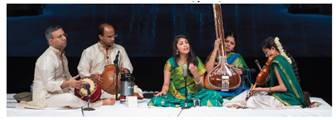 Over the years, the Indian dance arangetrams have become de rigueur for young women among Indian-Americans. Less common, though, is music arangetrams as they require years of training in shruti shuddham (voice training), layam and kaala-pramanam (complex rhythm patterns in Indian classical music), and clarity in diction in rendering Tamil, Telugu, Kannada, Sanskrit, Hindi, and Marathi krtis (lyrics).
Over the years, the Indian dance arangetrams have become de rigueur for young women among Indian-Americans. Less common, though, is music arangetrams as they require years of training in shruti shuddham (voice training), layam and kaala-pramanam (complex rhythm patterns in Indian classical music), and clarity in diction in rendering Tamil, Telugu, Kannada, Sanskrit, Hindi, and Marathi krtis (lyrics).
Pallavi’s teacher Sujana (picture below) has trained her student well in all these facets to gracefully handle the program with many pieces that included alapana, 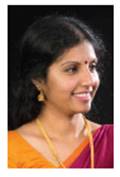 neraval and swara prastharam — all hallmarks of a confident student going on stage for the first time. Pallavi’s passion, discipline, and long hours of hard work were evident in the almost flawless solo recital.
neraval and swara prastharam — all hallmarks of a confident student going on stage for the first time. Pallavi’s passion, discipline, and long hours of hard work were evident in the almost flawless solo recital.
Her accompanying percussion artists were seasoned artistes. Jayant Balasubramanian (Mridangam) and Ravi Balasubramanian (Ghatam) are veterans. Pallavi was ably guided by these talented seniors who provided excellent structure to the concert, providing gravitas to the recital. Sushmita Ravikumar, a junior at Ohio State University, very ably provided violin accompaniment with great talent and elan. Preetha Narayanaswamy provided Tanpura support.
The encouragement and support provided for the young vocalist by the accompanying senior artistes were acknowledged by Smt. Tara Anand, the chief guest of the evening and the guru of Sujana, in her remarks.
Pallavi had requested that any gifts be in checks payable to the Chinmaya Mission. Over $8500 collected thus — which overwhelmed the Muluks — was given to the Mission.
♣
Jindal’s Madcap Pursuit for the White House
Posted by admin in October 2015 on October 23, 2015
By Kollengode S Venkataraman
In the overcrowded field of Republicans seeking nomination for the White House, 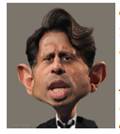 Louisiana’s Bobby Jindal became irrelevant on the very day he announced his intention in late June. I was not a fan of Jindal even when he was a rising GOP star years ago. This is what I wrote in 2010 on Jindal:
Louisiana’s Bobby Jindal became irrelevant on the very day he announced his intention in late June. I was not a fan of Jindal even when he was a rising GOP star years ago. This is what I wrote in 2010 on Jindal:
“When Jindal as governor was invited to the White House Diwali function — which has now lost all its religious significance — he did not show up. Probably because of the bad optics of the video clips filling the “very Southern†Louisiana airwaves in election commercials showing a brown Jindal in an Indian “Hindu†function in the midst of other brown Indians. That will not sit well in the deeply ‘Southern’ Louisiana… … Jindal, the Ivy league Brown University graduate in biology, in his anxiety to get elected as the governor of Louisiana, was also running away from Darwin’s Natural Selection and embraced the Judeo-Christian idea of creation in which the universe is only 6,000 years old, give or take a few centuries…â€
No sooner had Bobby Jindal announced in June seeking the GOP nomination for the White House, comments from mainstream readers were pungent and sarcastic. From the Washington Post:
“According to conservative GOPers life begins at conception. So Piyush Jindal isn’t even eligible to run for President, because he was conceived in India.†[Note: Jindal was born a few months after his pregnant mother landed in the US.]
“The mistake is thinking that being smart always translates into good policy. Plenty of smart people trade ambition and greed for good policy. Jindal is just the latest example.â€
“For laughs, I have to report that the NOLA.com’s online headline was not Jindal’s announcement but the protestors at the event—you know how bad the guy is when his own citizens will take the time to derail him… … Usually these people support … anything … coming out of the state on loyalty alone.â€
“Bobby is thankful for Mississippi; because without it, Louisiana would be dead last in just about every state ranking category.â€
From the New York Times:
“…[M]ost of us here in Louisiana are eager to enter the post-Jindal era… His has wrecked the state budget, state schools, state roads, state healthcare, and more — all to stay true to the “oath†he took not to raise taxes. Some of us are willing to pay a little more in order to have better schools, roads, healthcare, etc.; even the conservatives among us want these things and want Jindal out.â€
“A true American success story. Born of immigrant parents. Is a brilliant student. Graduates at the top of his high school class. Gets a first class education at prestigious Ivy League School. Goes on to become a Rhodes Scholar. Works at McKinsey and Co. Is soon elected Governor of Louisiana at the age of 36. This is where things go wrong… … Seems all that promise hits a brick wall when it comes down to actually doing something productive. My recommendation [for Jindal] is to go back to McKinsey and Co. where the talented Mr. Jindal is likely to only bankrupt one or two corporations rather than an entire state. This fellow seems to have peaked in high school!â€
Normally, in American electoral politics, candidates get support at least from their own ethnic groups. But Desis joined the mainstream chorus against Bobby. Here is an example from Hari Kondabolu, an Indian-American comedian in a radio network:
“Anyone got photos of Bobby Jindal eating gulab jamun or jelebi? Please release them. It may destroy his presidential campaign.â€
—     n
International Air Travel: US & Persian Gulf Air Carriers Compete — Travelers Stand to Gain
By Kollengode S. Venkataraman
e-mail: ThePatrika@aol.com
For people traveling from second-tier cities like Pittsburgh and Raleigh in the US to second-tier cities in the Indian subcontinent (Ahmedabad, Amritsar, Lucknow, Peshawar, Kochi) the gate-to-gate travel time can be daunting. Often three stopovers — a major hub in the US, a brief layover in Europe, another major hub in India like Mumbai or Delhi with long layovers.
Seniors or people traveling with infants and kids despair even before they leave home. This has changed now.
A few years ago, the Big-3 Persian Gulf carriers — Emirates, Etihad, and Qatar — started their nonstops to US cities beyond JFK. We now have 18 nonstops to US cities such as Dallas, Houston, Washington DC, San Francisco, Boston, Seattle, and Miami, to their hubs in Doha, Abu Dhabi, and Dubai in the Persian Gulf. Incidentally, Dubai and Abu Dhabi, new entrants to high-end international travel, have state-of-the-art hubs and airport facilities. Later, the Big-3 US carriers (Delta, United, and American) also started their nonstops to the Persian Gulf to get their market share.
The Big-3 Persian Gulf carriers have nonstop flights from their hubs to second-tier cities like Ahmedabad, Amritsar, Goa, Kochi, Kozhikode, Lucknow, Karachi, Lahore, Islamabad, Multan, and Peshawar in the Indian subcontinent.
Several regional air carriers like Air India Express, Jet Airways, IndiGo also have nonstops from these Persian hubs to several other second-tier cities in the Indian subcontinent.
Because of these options, the gate-to-gate travel times between second tier cities in the US and the Indian subcontinent are shortened anywhere from 4 to 6 hours or even better.
With the Open Skies policies in the US for international carriers, the Big-3 US carriers are feeling the heat from competition from these big Persian Gulf carriers. These new comers have much younger fleet, better and wider range of in-cabin service (like food, entertainment, and importantly, cabin crew). Besides, the Persian Gulf hubs are huge shopping/entertainment complexes with even hotels within the airport for long layovers. The Business Class service in these new entrants is far better than what the US carriers offer.
So, these new Persian Gulf airlines are now luring away international travelers from established US and European carriers such as Lufthansa, KLM, British Airways, Delta, United, and American. These legacy airlines for decades had almost 100% share of the international travelers from the Indian subcontinent, the Middle East, and Africa. Those days are gone for good.
The Big-3 US carriers are complaining to the US government that the Persian Gulf’s Big-3 get unfair financial subsidies from their governments. Not many in the US who understand global travel are convinced.
In any case, international travelers in second-tier cities in the Indian subcontinent and North America now have more travel options, shorter gate-to-gate travel time between their home towns in the US to their destinations in India, and possibly also less expensive tickets. The in-cabin service in US carriers may even improve with competition, and the competition will keep the air fare in check.
In the man-eat-man world of international air travel business, India’s air carriers and big airports in India have missed chance to lure international travelers compared to the Persian Gulf’s Big-3 carriers and their hubs like Dubai. On this also, India will be perpetually in the catching-up mode.
The Pittsburgh International Airport has excellent infrastructure and resources for easy, hassle-free and quick international arrivals and departures. And within a 100-mile radius, this is a first class airport.
There are enough international travelers — business people, students, government officials, researchers and university teachers — living within a 100-mile radius around the Pittsburgh Metro region.
If these travelers’ final destination is anywhere in the Indian subcontinent, Southeast Asia (Singapore, Kuala Lumpur, Bangkok), East Africa, or the Middle East, and if we have a nonstop from PIT to a Persian Gulf city like Dubai, Abu Dhabi or Doha, we can reduce our gate-to-gate travel time by at least 6 to 8 hours, or even longer. And the air travel more convenient.
If you know elected officials in Pittsburgh, or the airport administrators at PIT, or our regional business leaders, persuade them to look beyond Europe and explore getting a nonstop to one of the Persian Gulf hubs from the Steel City before some other city in our region gets it. ∎ END
Proxy War: The Syrian Axis Dividing the World
Kris Gopal, South Hills, PA
e-mail:Â gutcut@comcast.net
A proxy war as defined by the Oxford Dictionary is a war instigated by a major power, which does not itself become involved. Typically proxy wars function best during cold wars, as they become a necessity in conducting armed conflict between two belligerents while continuing cold warfare. Proxy wars are those in which the main actors face conflict through the use of other means—proxies. These proxies range from aid and arms supplies to full use of troops, not simply the act of war itself; there are many ways for outside forces to contribute to war and conflict between entities other than itself. Proxy war is covert and illegal, yet still frequently used as a strategy today. The earlier conflict between the regime and the Taliban in Afghanistan (in 1970) and how the super powers, United States and Russia, were drawn into the conflict is a classic example of proxy war.
Our history is replete with innumerable proxy wars from time immemorial — from the Abhyssinian-Adal war in 1529, from the colonial era to the present second Saudi-Yemen War. The list is too numerous to mention all.
The present Syrian conflict is a proxy war at best, with the civil uprising in the country being manipulated by three super powers, China, Russia and United States of America. Syria is a complicated place and an important player in Middle Eastern and global relations.
First and foremost, Syria is the third arm of the anti-Israeli and anti-West, Iran-Hezbollah-Syria alliance, a Shia threesome that opposes the set of Sunni-led powers in the Middle East. Syria’s population is dominated by Sunnis, but the Assad family, who are Shias, controls the country.
In addition, Syria buys some $150-million worth of arms from Russia every year and hosts a Russian naval port on its Mediterranean Sea Coast. It has been lorded over by the ruthless Assad family for more than 40 years, with democracy a forbidden notion. And it is situated at a continental crossroads, between the energy riches of Eurasia and the Middle East and the energy-hungry markets of Europe.
Syrian conflict has triggered something more fundamental than a difference of opinion. In sixteen months, the situation in Syria has mutated from an uprising in outlying areas into full-scale civil war. Now it has mutated into a proxy war between the great powers.
The Russians have been arming Bashar al Assad’s regime and the West is arming the rebels. The Saudis and the Persian Gulf countries are funneling weapons straight to the Sunnis. The arms are trickling across the Syria’s borders with Lebanon, Turkey, Iraq and Jordan. The CIA has been channeling the weapons to the “right†people away from al-Qaeda, but who the right people are anybody’s guess. A rag tag of village insurgents and army defectors is coming together as a fighting force. The regime and its opponents are now fighting with special savagery.
While the savagery is going on, the Syrian exile leaders are frittering away time sitting outside, where they discussed their plans in Cairo to get their act together. Divisions along the lines of clan, tribe, ethnicity and Islamic sects would make a united front difficult to achieve. It appears that the Assads, father and son, were more skillful than Libya’s Muammar Qadaffi in keeping their opposition weak and divided.
So the Great powers are facing off in the most volatile region on Earth, which may have a destabilizing effect in the neighboring countries of Jordan, Lebanon and Iraq, and even beyond. Russians and Americans are restrained because of the dangerous standoff over the neighboring Iran.
Russia helped build Iran’s nuclear program, China needs Iranian oil and both are willing to support Iran’s defense of the region’s Shias, including Syria’s Alawites. The US and Saudis are lined up behind the Sunnis.
But while Russia and the US want to keep the confrontation at low ebb, their proxies — Iran and Syria on one side, and Israel and Saudi Arabia on other — will seek to drag them deeper. Both Russia and China see the Syrian issue through their own political lenses. They understand Assad well and support the dictator.
In this complex world of fighting by proxies, now U.S is finding itself caught in the proxy war between Iran and Saudi Arabia.
References.
Making sense of proxy wars, by Michael Innes.
The world deployed by Scot L Bills.
World History, by Jonathan Drsner. Pittsburgh State University.
The New York review of Books. How Syria divided the world,  by Michael Ignatiff
Caught in the cross fire, by Massimo Calabresi, in Time Magazine. April 2015
♦
5-k Charity Event by Pittsburgh Indian Community & Friends (PIC)
By PIC-5-k Volunteer Team, Pittsburgh, PAÂ
We call Pittsburgh our home. So, let’s give back to the city that all of us have benefited from in many ways. Many of us support nonprofit charities on an annual basis. However, there is still a perception in local public that our community does not contribute enough and that we are somehow indifferent to the local issues despite our education and success. The mission of PIC-5k is to bring our community together to raise funds for deserving Pittsburgh-based nonprofits and demonstrate our commitment to Pittsburgh.
 So, in this spirit, we organized our inaugural event last September. We were pleased that over 600 people participated in the event and raised over $35,000. This was accomplished by the support from over eighteen organizations representing our diverse backgrounds and religious organizations. We came together under the canopy of the 5k event — an impressive way to showcase our Unity in Diversity!
So, in this spirit, we organized our inaugural event last September. We were pleased that over 600 people participated in the event and raised over $35,000. This was accomplished by the support from over eighteen organizations representing our diverse backgrounds and religious organizations. We came together under the canopy of the 5k event — an impressive way to showcase our Unity in Diversity!
The funds raised directly benefitted these Pittsburgh-based nonprofit organizations: 1) Homeless Children Education Fund and 2) Primary Care Health Services, Inc.
The PIC-5k this year is on Saturday, September 12th at the North Park Boat House. Mark your calendar.
We urge you to join this event with family, friends and colleagues. The scenic course takes you around the lake, and it is perhaps the best way to meet and greet all your friends and even make new friends. This is a family event and people of all ages are encouraged to participate. Also, the event is open to all and please ask your friends, neighbors and coworkers to join regardless of their background. Help us to reach our goal of 2,000 participants this year.
Let’s make a difference in the region and the larger community that we are a part of.  Please visit us at http://pic5k.org/, and like us at  www.facebook.com/PIC5K
Our criteria for selecting registered Nonprofits for support with funds: 1) Focus on serving the local community. 2) Small, yet effective organizations where our contributions can make a difference. 3) Specific programs with measurable outcome.
With these objectives we set for ourselves, we made a list of local Nonprofits and understood their activities. We then short-listed a few of them for our purpose, visiting them talking to their leaders to understand their operations and the impact on the community.
We satisfied ourselves that the Nonprofits would benefit from our contributions, and further that they would work with us and report to us for assessing the impact of our support.
♦ Â
On Intellectual Arrogance
By Kollengode S Venkataraman
e-mail:Â ThePatrika@aol.com
In all cultures, there is always an undercurrent of tension between wealthy patrons and the recipient honorees receiving their patronage. This is simply because the recipients of the patronage — typically poets, painters, musicians, sculptors, and others with creative minds — are temperamental people to begin with; they are also conscious of their creative talents, and the lack of it among their patrons. The patrons, while aware of their limits, are sometimes genuine to help these artistes. But more often, they want to tell the world that they patronize artists. They also know the recipients need their support much more. In all sophisticated cultures, this patronage is expected of wealth and power. In the Krishnadevaraya’s court in the Vijayanagara Empire, he had eight poets of great talents, called Ashta-dig-gajas, literally, “elephants in eight directions.†Allasani Peddanna and Nandi Timmanna are the famous two.
Both the patrons and the recipients need great skills to negotiate their mutually dependent transactional interactions. Otherwise tension spills over in public. I have heard these stories in 20th century India:
♣ Â Sahir Ludhianvi, a great Hindi/Urdu poet went with idealism to Pakistan on Partition in 1947. Once in Pakistan, he saw that the literary ambience there was not what he expected. He was even jailed for his leftist writings in Savera, the Urdu daily. In disgust he returned to India, never going to Pakistan even as a visitor. In India he was a star lyricist.
♣ Â Veteran Hindustani vocalist Bade Gulam Ali Khan too went to Pakistan during Partition hoping for better patronage. He was disillusioned with the condescension he got from the bureaucrats running Radio Pakistan. He returned to India in revulsion. He too was a star in India.
♣  Closer to our time, I’ve heard that there was some bad blood between the Andhra-born Telugu-speaking Balamuralikrishna, the veteran Karnatic vocalist based in Chennai, and N.T.Rama Rao, the founder of Telugu Desam Party and the powerful chief minister of Andhra Pradesh. Balamuralikrishna never performed in Andhra Pradesh as long as N.T.Rama Rao was the chief minister.
♣  Poet Kannadasan was a legend in his own life as a lyricist dominating Tamil cinema in the 50s, 60s, 70s; and well into the 80s. In the Tamil Cinema dominated by superstar heroes, MGR ruled the roost in this time. There was a disagreement between MGR and Kannadasan. Kannadasan felt slighted in the exchange between the two. Feeling slighted, Kannadasan simply refused to write lyrics for MGR films for years and years and yet dominated Tamil cinema as a song writer. That is how self-assured the poet was.
Finally, MGR recognized his mistake, relented and invited Kannadasan to write lyrics for his film. The very fist song he wrote for MGR after this invitation was a great hit.
♣ Â O.P.Nayyar, a well-known music director never used Lata Mangeshkar when Lata dominated Hindi cinema, because of personality clash. Nayyar went on to become a celebrity music director without Lata.
There is nothing new in the intellectual arrogance of people with talents. As a matter of fact, this is very old. Here is an example from 5th century India of a Sanskrit poet responding to the perceived arrogance of his patron king (source: Vairagya satakam by Bhartrhari).
 Here is the non-poetical Translation:
Here is the non-poetical Translation:
You’re a king; [but] we too are self-assured of our wisdom acquired from teachers we served;
You’re celebrated for your wealth and grandeur;  our fame [too] is known in all quarters spread by our peers.
Thus, there is a divide between us both. If you are cold towards us, Â we too are perfectly content to be indifferent towards you.
In the 10th century Tamil Nadu lived Kambar, a great poet, who rendered Ramayanam in 10,000 Tamil verses that goes by his name, Kamba Ramayanam. His patron was the Chola King Kulottungan. Due to some unknown reason — unknown to me in any case — Kambar felt insulted by his Chola patron.
He left Kulottungan’s court in disgust, writing his resignation letter in a four-line verse (in the style of veNbaa) dripping in anger and sarcasm.
Here is the Tamil original:
Here is a free translation of the above sarcastic verse dripping composed in rhetorical flourish:
And you too are a king? And yours is this prosperous kingdom?
I nurtured Tamil [here] knowing you as well as I do [now]?
Is there a king who will NOT eagerly take me into his court?
Is there a bough in any tree that will not accept a monkey?
I hope I succeeded in bringing out in the English translation the rhetorical flourish in the Tamil original. This is perhaps the only instance of a resignation letter in verse form conforming to all the rules of grammar, rhyming, and alliteration, dripping in anger borne out of a combination humiliation and intellectual arrogance.  And written in supreme self-confidence.
When the patrons and recipients know both of them need to nurture their symbiotic relationship, both gain. Even the outside world gains. After all, true artists are kings in their own right. But when this does not happen, there is always potential for hell breaking loose.
♦
India in Transition: Trying to Initiate A Radical Arranged Marriage
By Kollengode S Venkataraman
e-mail:Â ThePatrika@aol.com
There is a wide perception in the West that Indians are “traditional†and “orthodox†and very caste-conscious when it comes to marriage. One proof they cite are the matrimonial ads in Indian dailies — for that matter also in Pakistani and Bangladeshi dailies — in which the grooms’ and brides’ parents seek alliance from parents of potential brides and grooms respectively, identifying their religion, sects and subsects, caste and subcastes, native tongue, food habits, and so on.
Muslims, Christians, and Sikhs are no exception in this even though Christianity, Islam and the Sikh faith do not nominally recognize caste. The caste system may have a Hindu origin, but today, in practical terms, it pervades the entire South Asian population across all faiths. However, India is also rapidly changing. This is obvious to those willing to see and understand the details of today’s marriages not only among the upper crust and its middle class, but also among the working poor. In this milieu, any departure is a welcome change.
Given this context, one recent matrimonial ad in a Mumbai tabloid drew wide attention for its departure from the norm, and went viral. This unique matrimonial ad invited proposals for a gay Iyer man (Iyer is a stereotypical name of a Tamil Brahmin subsect) from potential gay grooms. Later, the man’s identity was revealed: Harrish Iyer. See the picture.
Incidentally, South Indian Tamil Brahmins are caricatured in the media all over India as orthodox, religious, traditional, old-fashioned, subservient, compliant… and not courageous, daring and not entrepreneurial. The famous examples in my younger days (1960s and 1970s) were the well-known Ranganathan character in the Hindi film Rajni Gandha; and the actor Mehmood’s tasteless slap-stick caricaturing of Tamil Brahmins in Hindi films.
However, people outside the Tamil Brahmins’ group also would grudgingly acknowledge privately this: these Brahmins, in general, are studious, hardworking, diligent, and single-minded in their pursuits. They are also self-effacing and low-key in their public persona and with their higher-ups. The Tamil Brahmins are also reviled subtly and not-so-subtly by outsiders for these very reasons. The powerful Brahmin-hating Dravidian Movement in Tamil Nadu in the 1940s, 50s, and 60s portrayed Tamil Brahmins as wily, crafty and diabolical; and also as the root cause for all evils in the Tamil society.
In any case, the matrimonial ad read, “Seeking 25-40, well- placed, animal-loving, vegetarian groom [for a man] (36, 5’11”) who works with an NGO, caste no bar (though Iyer preferred).†This matrimonial ad from a gay young man from among the tradition-bound South Indian Brahmins seeking alliance with a gay man, understandably, went viral. Within a day or two Harrish Iyer, got over 70 proposals.
The Hindustan Times reported (www.tinyurl.com/Gay-Iyed-Wedding-Ad) Iyer saying, “Most proposals … … were from men from the Iyer community, given the preference mentioned in the ad… … Proposals had come from all over world, including from Australia, the UK, the US and even Saudi Arabia. Apart from Iyers, many Gujaratis and Muslims also expressed interest… … Some proposals said they were fine with all my preferences and wanted to marry me, but were meat-eaters. An interesting proposal came from Abu Dhabi, where a man offered me his palatial house to live in after marriage.â€
Though the ad was radical in every measure, there was also a traditional, and simultaneously, a very radical Indian twist to this ad. The full ad reads thus: “Seeking 25-40, well placed, animal-loving, vegetarian groom for my son (36, 5’11”) who works with an NGO, caste no bar (though Iyer preferred).†(Emphasis mine).
After all, the ad, in one fundamental measure, was not radical at all, but very, very traditional. For, it was placed, not by Harrish Iyer himself courageously seeking a same-sex partner in marriage, but by Harrish’s mother Padma Iyer, who supports her son’s gay identity and even walked with him in the Queer Azadi Mumbai parade. At another level, it was as radical as it gets anywhere in the world — a mother placing a matrimonial ad seeking proposals from other gay men for her gay son.
We wish Harrish Iyer well in his life whoever he chooses to be his partner and wherever he chooses to live. And we hope that in his married life with a gay partner of his choice — and also his mother’s choice, if you go by the ad — the Indian tradition stops with his mother helping him choose his partner. Ok, give her some slack: Maybe, with her finalizing Harrish Iyer’s wedding details.
If it extends beyond his traditionally arranged, yet very radical gay Indian marriage, it has the potential of his mother’s shadowy presence interfering — and even wrecking — his gay marriage, as it happens so often in traditionally arranged straight Desi marriages.
♦
The Pittsburgh Triveni Samskrita Mela 2015
By Asmita Ranganathan, Sudarshan Narayanan, Harichandan Mantripragada, and Jyotsna Kalavar
Samskrira Bharati USA, Pittsburgh Chapter
The Samskrita Bharati USA’s Pittsburgh Chapter, extends an invitation to all Sanskrit aficionados in and around the Pittsburgh area to participate and to support Pittsburgh Triveni Samskrita Mela 2015, a festival celebrating Samskritam. We hope that this Mela will serve as a forum for all Sanskrit aficionados to come together in propagating this great language.
Triveni in the title draws an analogy between the confluence of the three holy rivers of India, Triveni Sangam in Prayaag, now called Allahabad, considered a seat of learning and Hindu culture; and the confluence of the three rivers of Pittsburgh, a place we endeavor to make an abode for Sanskrit and Sanskriti. Here are the details of the events:
When: September 19th (Saturday), 2015 from 11a.m. to 5 p.m.
Where: The Holiday Inn, 2750 Mosside Blvd, Monroeville, Â Â Â Â Â Â Â Â Â Â Â Â Â Â Â Â Â Â Â Â Â Â Â Â Â Â PA 15146.
Activities: Songs, dances, skits, games, and others for adults and youngsters all in Sanskrit! The event is open to all. Further, there will be:
Exhibits portraying the legacy of the language.
A book stall displaying books for purchase,
to kindle the interest of both beginners and advanced students of Sanskrit, featuring a wide collection of media resources.
Samskrita Bharati USA (www.samskritabharatiusa.org) is a non-profit organization committed to reviving and popularizing Sanskrit as a spoken language, and thereby enabling us to access our timeless and rich cultural heritage. A sapling of this tree obtained from its parent organization, Samskrita Bharati in India, was planted in the US in 1995.
Twenty years later today, that sapling has grown into a tree bearing fruits of success in the form of increased engagement in speaking Sanskrit while its branches are growing to reach out and provide shade to many a Sanskrit enthusiast. In just a few years, Samskrita Bharati USA has grown from a single center in California to more than twenty all around the USÂ with hundreds of volunteers.
The Pittsburgh Triveni Samskrita Mela 2015 is being held to commemorate Samskrita Bharati USA’s 20th anniversary.
For questions and/or enquiries, please contact:
Asmita Ranganathan: (412) 276-1699
Harichandan Mantripragada: (412) 849-9622
Sudarshan Narayanan: (412) 608-5481

